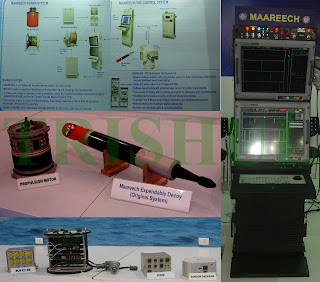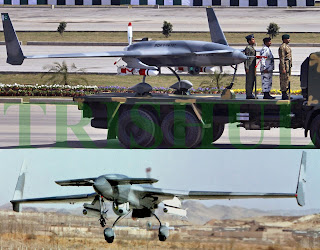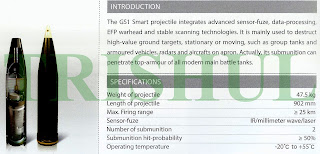The Wing Loong-2 becomes Pakistan’s second
UCAV acquisition, the first being the Pakistan Army-owned Cai Hong-3A/Al Burraq, which was developed by the China
Academy of Aerospace Aerodynamics (also known as the 11th Academy), which
belongs to the China Aerospace Science & Technology Corp or CASC (also
known as the 701st Research Institute). The Cai Hong-3A/Al Burraq comes armed
with YC-200 laser-guided guided-bombs and AR-1 laser guided air-to-surface
missiles.
Tracing The Common Lineage Of NORINCO’s ASH-1 & Kalyani
Strategic Systems Ltd’s Bharat-45
In terms of both external looks and performance
parameters, NORINCO of China’s ASH-1 155mm/45-cal towed howitzer and the
Bharat-45 166mm/45-cal towed howitzer from India’s Kalyani Strategic
Systems Ltd (KSSL) are identical. And that’s because both are derivatives of
the baseline GC-45 155mm/45-cal towed howitzer that was originally designed by
the Canada-based Space Research Corp (SRC), which was created and owned by the
legendary ballistics expert, Dr Gerald Bull, since the mid-1970s.

The
GC-45’s general design emerged after two decades of work by Dr Bull with fin-stabilised,
extended-range full-bore (ERFB) ammunition: a pointed
shell with much lower drag at supersonic speeds.
For long-range applications Dr Bull had added a base-bleed system
(originally invented in Sweden) that could be screwed onto the standard shell, as
well as an even longer-range artillery projectile with a rocket booster. The GC-45
towed howitzer designed by Dr Bull to fire such projectiles had a 23,000 cubic
cm (1,400 cubic inches) chamber, a 45-calibre rifled barrel with
1/20 right-hand twist fitted with a conventional muzzle-brake. Its
breech was a conventional screw with interrupted thread. In 1977, Dr Bull came in touch with South Africa’s state-owned ARMSCOR
holding company, which subsequently designed a new mobile mounting that was
able to handle the increased recoil. It used a sole-plate to lift the gun-carriage
to take the four wheels off the ground. The chassis had the option of being
powered by a small diesel engine acting as an auxiliary power unit, driving the hydraulics that could set up the
howitzer in two minutes, and move it short distances. The resultant
155mm/45-cal towed howitzer became known as the G-5. Meanwhile, Dr Bull outsourced
series-production of 155mm ERFB projectiles from the Spain-based Santa Barbara
under a US$30 million contract. These were later shipped directly from Spain to
South Africa in order to avoid the then prevailing international arms embargo
against South Africa. The G-5 entered service in 1982.

In
1982 itself, NORICUM, the subsidiary of Austria’s VOEST-Alpine AG, purchased the design rights to the GC-45 after SRC
moved to Brussels from Canada. NORICUM made a number of design re-engineerings
to the baseline GC-45 design, and as a result the GHN-45 155mm/45-cal towed
howitzer emerged. First export customer of this howitzer was Iraq, which placed
a $300 million contract for 110 GHN-45s, along with 41,000 rounds of 155mm ammunition
whose production was outsourced by Dr Bull’s SRC from Belgium-based PRB.
Deliveries were made in 1984 and 1985. The number of GHN-45s supplied to Iraq
was eventually 200. Since both Iran and Iraq were
under a UN-imposed arms embargo at that time, the GHN-45s were shipped to Iraq via
Jordan.

Meanwhile, three years earlier, in 1980, in response to an
engineering contract awarded to SRC by China’s state-owned China North
Industries Group Corp (NORINCO), Dr Bull began fabricating the155mm/45-cal
GC-45’s prototypes with the help of Santa Barbara of Spain. By 1983 these were successfully
field-tested by China’s PLA Army in the desert region of Baotou in the Inner
Mongolia Autonomous Region, following which NORINCO began series-producing them
under the designation PLL-01.
NORINCO’s 674 Factory (Harbin First
Machine Manufacturing Limited Company), 123 Factory (Heilongjiang Hua’an
Industry Group Company) and 127 Factory (Tsitsihar Heping Machine Shop) were
the principal production authorities of the PLL-01 and its related ammunition family since 1987. This was the PLA
Army’s first field
artillery howitzer to have adopted the NATO-standard 155mm barrel diameter
instead of the Soviet-/Russian-standard 152mm.
For export, the PLL-01 later became known as
the ASH-1, with 18 of these being sold to Algeria in 2014 along with NORINCO-supplied
Type 702D meteorological radars, Type 904-1 weapon locating radars, and
Battalion/Battery Command Post vehicles.
In 1986, NORICUM was
renamed NORICUM
Maschinenbau und Handels GmbH, and in October 1989 it was renamed again as Maschinenfabrik
Liezen AG (MFL). Now, fast-forward to 2012 when India’s KSSL imported
from MFL a service version of the GHN-45 (which has since been renamed as the
Bharat-45), and at the same time also bought, knocked down and transported to
India an entire field artillery industrial production facility from RUAG of
Switzerland.

At Mundhwa near Pune, a previous heat-treatment workshop is today
a facility for making 125mm and 155mm barrels, breeches and muzzles, making it
India’s only private-sector company, and the second one in the country, apart
from the Kanpur-based production facility of the state-owned Ordnance Factory
Board, to have this capability. Production-engineering machinery imported from RUAG
can produce barrels up to 9 metres in length, while the rifling and
autofrettage machines can make bores ranging from 105mm to 8-metre long 155mm/52-cal.
High-strength steel alloys for the barrels are sourced from the neighbouring Kalyani
Carpenter Special Steels.



Thus, the only major difference
between the ASH-1 and Bharat-45 today is in the arena of vectronics suites:
while the former uses NORINCO-developed vectronics, for the Bharat-45 the
vectronics suite comes from Israel’s ELBIT Systems. But while both towed
howitzers are comparable in performance, in the global export market, NORINCO
undoubtedly has a distinct edge, thanks to its ability to provide total
solutions, i.e. not only field artillery howitzers, but also a wide range of
155mm ammunition, guided-projectiles, their electronic fuzes and bi-modular
charges, along with command-and-control/fire-direction systems.
IAF Moves Ahead With S-125 Pechora
SAM Upgrade
A much welcome spinoff from
the DRDO’s two-decade long R & D activities for the Akash-1 MR-SAM
programme has now resulted in the development of an indigenous upgrade package
for the Indian Air Force (IAF) remaining S-125 Pechora SAM systems that will
extend their service-lives by another 12 years.
Restricted tenders worth US$272
million to upgrade 16 of the original 30 squadrons of the IAF’s S-125 Pechora
SAM systems under the ‘Make in India’ programme were floated in May 2016 and
were sent to TATA Power SED, Larsen & Toubro, Reliance Defence, Offset
India Solutions, Amertec Systems Pvt Ltd, Bharat Dynamics Ltd (BDL), Bharat
Electronics Ltd (BEL) and ECIL. While the V-601 missiles will be refurbished by
BDL with the help of Russia’s OJSC Concern Almaz-Antey, the existing analogue fire-contol
systems will be fully digitised by Indian OEMs, following which they will be
integrated by BEL with the IAF’s IACCCS network.
BEL will also deliver the
Rohini S-band 3-D CARs and related motorized command-and-control posts that
will replace the older P-19 early-warning radars. Amertec Systems Pvt Ltd will
supply the digitised LRUs and related ATEs for the upgraded SNR-125 pulse-Doppler
tracking, fire-control and guidance radars. Deliveries
will begin 42 months after contract signature.
However, this upgrade contract
does not in any way postpone or stall the IAF’s plans for procuring 18 squadrons
of Barak-8 MR-SAMs and LR-SAMs.
The Indian Air Force’s S-125 Neva (export name Pechora)
uses the V-601 (or 5V27) missile has a length of
6.09 metres, a wingspan of 2.2 metres and a body diameter of 0.375 metres. This
missile weighs 953kg at launch, and has a 70kg warhead containing 33kg of HE
and 4,500 fragments. The minimum range is 3.5km, and the maximum is 25km. The
intercept altitudes are between 100 metres and 18km. Radars used for the original
S-125 included the following:
P-15M(2) TROPA 1RL13 C-band
target acquisition radar, which comprised a single antenna on a tethered
latticework mast. It was employed to improve low altitude coverage, but also to
permit use of the radar in heavily forested terrain where the height of the
foliage canopy exceeded the height of the antenna phase centre in the P-15. The
P-19 DANUBE 1RL134 was the improved 2-D UHF follow-on to the
P-15 with a range of improvements.
SNR-125 I/D-band tracking, fire-control and guidance radar, which uses
a pair of fixed scanned trough antennas to generate flapping fan shaped beams,
but the design is inherently SORO with a separate transmit antenna mounted
between the characteristic chevron arrangement of trough antennas. Optical
adjunct tracking using the 9Sh33A Karat 2 television telescope has been
installed on later variants, initially the SNR-125M1. The antenna at the
top of the turret is used for the low power missile FMCW uplink channels. The
antennae functions are, respectively:

* UV-10: Transmit for target and missile
tracking, Transmit/Receive for rangefinding, Transmit/Receive for initial
target acquisition, Receive for clutter cancelling channel. The boom mounts a
cluster of feed horns, including a rotating scanning feed, each producing
unique mainlobes. The scanned acquisition beam mainlobe is 1° wide and swept
through a 15° arc in elevation at 25 Hz, the mainlobe for target tracking, transmit
and rangefinding receive is 10° wide.
* UV11 F1 and F2: Receive antennas for target
and missile transponder beacon tracking. These produce 1° x 15° fan shaped
mainlobes which sweep through a 15° arc.
* UV-12: Missile uplink antenna for the FMCW
12 Watt command link.

The SNR-125 was designed to acquire targets using
only bearing and range inputs from an external 2-D acquisition radar, such as a
P-12/18 or P-15M. When acquiring a target, the radar head is rotated to the
target bearing and the UV-10 antenna scanning feed engaged to produce a 1° wide
pencil-beam swept in elevation. Once the target is acquired the radar is
switched into tracking mode, using the UV-10 antenna to transmit, the UV-10 to
receive for ranging, and the scanning UV-11 chevron receive antennas for angle
tracking. The radar head is mechanically steered in azimuth and elevation to
maintain track. The radar provides manual tracking, automatic tracking and
television angle tracking modes. The system provides five missile guidance
control laws, TT (CLOS), PS, MV (LoAlt), K (surface target attack) and DKM
(ballistic). Three missile uplink signals are employed, K1 and K2 for pitch/yaw
steering, and K3 for fuse control. Russian doctrine in the presence of heavy
jamming was often to cease emitting and use the scanning receiver to effect angle
tracking of the jammer, acquire the target with the TV telescope, and perform a
range unknown missile shot against the jammer in CLOS mode. Due to the addition
of a clutter canceller and analogue MTI circuits, the SNR-125 has significantly
better clutter rejection performance. Cited low altitude capability is against
targets as low as 20 metres (~60 feet AGL).

PRV-11 Vershina E-band height-finder radar.
The Indian
Army’s 48 motorised 9K33 OSA-AKM SHORADS have since 2006 been upgraded by Poland’s
Wojskowe Zakłady Uzbrojenia SA, with BDL refurbishing the 9M33M3 missiles with the help of Russia’s JSC Izhevsk
Electromechanical Plant KUPOL subsidiary of
OJSC Concern Almaz-Antey.
BrahMos-A Takes To The Skies
BrahMos Aerospace Pvt Ltd) and Hindustan Aeronautics Ltd (HAL) on June 25, 2016
successfully demonstrated the structural and electrical integration of the
BrahMos-A supersonic multi-role cruise missile (MRCM) with the Su-30MKI
heavy-MRCA.
The maiden demonstration
flight, carried out at HAL’s Nashik Division facilities, involved carriage of the
2.55-tonne BrahMos-A. Inflight missile ejection/launch tests will follow in the
near future, followed by test-firings by the year’s end.
The maiden flight took
place in the presence of HAL’s CMD T Suvarna Raju, BrahMos Aerospace CEO and MD Sudhir Kumar
Mishra, and Daljeet Singh CEO of HAL’s Nashik Division. Mishra congratulated
the joint R & D team of HAL, DRDO, IAF and BrahMos Aerospace for achieving
this technological feat, which will go down in the history as the world’s first
combination of supersonic MRCM and heavy-MRCA. He further noted the immense
contribution of V S N Murthy, Project Director (BrahMos-A), and the three
Deputy Project Directors—Gp Capt M K Srivastava, Gp Capt S Mondal and Gp Capt K
N Santosh.
The 290km-range BrahMos-A has been
designed to enable the Su-30MKI penetrate
deep inside hostile airspace for delivering deadly blows to heavily defended vital
installations from standoff ranges. A lighter version of the BrahMos-A, called
BrahMos-NG, is also under development. This variant will be destined for
M-MRCAs like the Rafale, FGFA, MiG-29K, and Jaguar IS/DARIN-3 deep
interdictors.

DAC Approvals Of June 2016
India’s Ministry of Defence
(MoD) on June 25, 2016 approved the much delayed purchase of 145 BAE
Systems-developed LW-155/M-777 heli-portable ultralightweight 155mm/39-cal
howitzers (UFH) worth about Rs 5,000 crore, and also the series-production of an
initial 18 OFB-built and developed Dhanush 155mm/45-cal towed howitzers out of
the 414 units the Indian Army requires. The MoD’s Defence Acquisition Council
(DAC), chaired by Defence Minister Manohar Parrikar, took up 18 proposals worth
an estimated Rs.28,000 crore for consideration and discussions. As a result,
the DAC also decided to accord Acceptance of Necessity (AON) standard to the
Indian Navy’s (IN) plans for procuring six next-generation missile vessels
(NGMV) under the ‘Buy Indian’ category for Rs.13,600 crore.

The direct industrial offsets,
under which BAE Systems will invest about US$200 million, will be pursued
independently with Mahindra Defence. While the first 25 UFHs will be procured
off-the-shelf, with deliveries commencing within six months of contract
signature, the remainder will be licence-assembled at the Assembly Integration
and Test facility that BAE Systems will commission in partnership with Mahindra
Defence.
OFB will deliver three
production-standard Dhanush howitzers for user-exploitation by June 30, an
additional three will be handed over by late September.
The DAC also approved a Rs.386
crore project for modernisation and augmentation of facilities at naval
dockyards and naval ship repair yards. Acquisition of five diving support craft
for Rs.150 crore was also approved. These catamaran-type vessels will be capable
of fully supporting operational/training dives in harbours and coastal waters. The
DAC also approved the procurement of indigenous cockpit procedures trainers worth
Rs.500 crore for the IAF’s Jaguar IS deep-penetration strike aircraft, and the setting
up of an indigenously developed electronic warfare range for the IAF at a cost
of Rs.1,300 crore.

Yet-to-be-resolved procurement
decisions include those concerning the upgrade of the IN’s Sea King Mk.42B and
Kamov Ka-28PL ASW helicopters, procurement of 16 ten-tonne shipborne NMRHs,
procurement of 16 shallow water ASW vessels, procurement of eight GRP-hulled
MCMVs, and the procurement of 15 mobile missile coastal batteries (MMCB) for
defence of the coastline against attacks from the sea.

What is both absurd and surprising is that the DAC did not decide on
whether to opt for a single design for both the NGMV and SW-ASW vessel
requirements. While the IN will eventually acquire 12 NGMVs (to replace
the existing 10 existing 477-tonne
Project 1241RE guided-missile corvettes, of which the first five were acquired
off-the-shelf from Russia between 1987 and 1991, while six were subsequently
licence-built by Mazagon Docks Ltd and Goa Shipyard Ltd at a unit cost of US$35
million), the 16 SW-ASW vessels with heli-decks are meant to be a new
capability accretion. The IN has specified that the range of the NGMV should be not less than 2,800nm
at sustained economical speed and 1,000mm at maximum speed. Max speed of the
NGMV, according to the IN, should not be less than 35 Knots, while the maximum sustained
speed should not be less than 25 Knots. In addition, the NGMV must carry a
minimum of 8 cruise missiles, while for air-defence, the vessel should be
fitted with a SR-SAM-type point-defence missile system (PDMS) for providing
credible near-360-degree anti-missile defence coverage. The PDMS should also be
able to engage sea-skimming anti-ship cruise missiles with a maximum speed of
Mach 3. In addition, a remotely-controlled, 15km-range 76/62 main gun within a
stealthy, faceted turret and using both radar and optronic fire-control systems
is also required, as is a close-in weapon system (CIWS) using similar fire-control
systems for low-intensity maritime operations (LIMO). Also specified is a
countermeasures dispensing system that should be capable of firing chaff in
all-round direction in distraction, seduction and centroid modes. The IN will
also in future install active-kill anti-torpedo systems.

For the SW-ASW vessel
requirement, the same hull design of the NGMV can easily be used, with the only
difference being the absence of cruise missiles on the former, which in turn
creates the space for accommodating a light twin-engined helicopter or a VTOL
UAV, plus remote-controlled autonomous surface or underwater surveillance
vehicles equipped with acoustic sensors. In addition, there is scope for both
types of vessels being equipped with identical integrated masts, PDMS and CIWS
suites.
When it comes to cruise
missiles for the NGMVs and the MMCBs, two indigenous vertically-launched
options are available. The first is the projected BrahMos-NG, while the second
is an anti-ship cruise missile version of the Nirbhay LACM. Both these missiles
will in future house an indigenous X-band monopulse imaging seeker that can use
different target recognition algorithms for attacking both hostile warships at
sea, as well as static installations on land.













































































































































